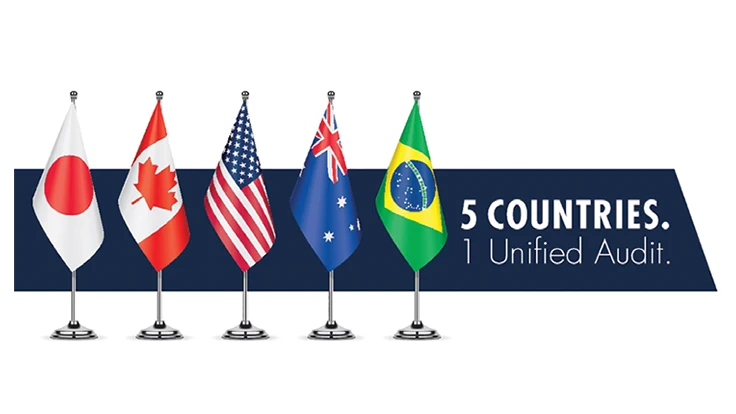
Ten years ago, the voluntary group of medical device regulators tasked with improving regulatory harmonization and convergence around the world – the International Medical Device Regulators Forum (IMDRF) – initiated preparations for a global approach to auditing and monitoring medical device manufacturing. Conceived was the Medical Device Single Audit Program (MDSAP), with the aim of improving the safety and effectiveness of medical devices globally. The stated vision is to: “Develop, manage, and oversee a single audit program that will allow a single regulatory audit to satisfy the needs of multiple jurisdictions”.1
In January 2014, an international coalition of five national regulatory agencies started a trial of the single audit program:
- U.S. Food and Drug Administration (FDA)
- Therapeutic Goods Administration (TGA), Australia
- Agência Nacional de Vigilância Sanitária (ANVISA), Brazil
- Health Canada
- Ministry of Health and Labour and Welfare (MHLW), Japan
A June 2017 report revealed the outcomes of the prospective proof-of-concept criteria, confirming viability of the MDSAP2. The program is now officially active in the five participating countries, although only Canada will enforce the MDSAP as mandatory, starting Jan. 1, 2019. Presently, 11 auditing organizations (AO) have been authorized to conduct the new single regulatory audit that will satisfy relevant requirements of the different authorities. However, there are applications underway to increase this figure, so it is expected that MDSAP will eventually provide a broader choice with reduced costs.
Pathway to compliance
The IMDRF has outlined instructions3 for the planning and execution of the MDSAP audit process, including an audit sequence and instructions for auditing each process. The MDSAP is structured into seven interrelated processes:
- Management
- Device marketing authorization, facility registration
- Medical device adverse events, advisory notices reporting
- Measurement, analysis, improvement
- Design, development
- Production, service controls
- Purchasing
Audits of each of these seven processes will adhere to the following structure:
- Goal
- Expected results
- Activities
- Relation with other processes
- Link with the ISO 13485 clauses
- Country-specific requirements
MDSAP audits are designed to take three years and three different audits: initial, surveillance, and recertification.
Treatment of non-conformities
Non-conformities (NCs) are ranked on a scale one to five, with the first three grades classed as minor infringements, and grades four and five classed as more serious lapses. If a medical device manufacturer is audited, and their processes have one or more grade five NCs, or two or more grade four NCs, a public health threat, or fraudulent activity, then the AO must inform regulatory authorities within five days. Usually the AO will complete an unannounced visit six to nine months later to check that suitable measures have been taken to rectify the problems.
AOs provide the audit package including NCs grading to the regulatory authority within 45 days after the audit. The manufacturer then provides plans to correct each non-conformance within 15 calendar days after issue of the NC report.
Advantages, drawbacks
Although the cost of preparing the QMS for a MDSAP audit could initially be a burden, long-term financial benefits come with greater harmonization of auditing requirements and a streamlined audit process. Manufacturers also benefit from standardization and coordination within QMS and other regulatory submissions.
The benefits from the point of view of international market access should not be underestimated. Becoming compliant with the regulations of five countries brings substantial advantages in terms of facilitating trade.
Perceived challenges of the program include pressure on internal resources and the need to train internal auditors. It is true that time and resources will have to be temporarily reallocated to prepare for MDSAP, but there will be guidance available for implementation.
Conclusion
Some stakeholders have voiced concerns about MDSAP, especially when it comes to overall impact, levels of market participation, and preparation cost. However, the single audit program will significantly reduce the time and effort spent preparing for, and responding to audits and inspections from various markets, while simplified international trade is another benefit. The long-term benefits of the single action plan for compliance far outweigh the short-term challenges.
Maetrics
www.maetrics.com
About the author: Peter Rose is managing director, Europe at Maetrics, and can be reached at 877.623.8742.
1MDSAP Functional Statement MDSP P0001.002 Version Date 2015-07-24
2Medical Device Single Audit Program, US Food and Drug Administration, July 2017
3Document Audit Model MDSAP AU P0002
Latest from Today's Medical Developments
- Arcline to sell Medical Manufacturing Technologies to Perimeter Solutions
- Decline in German machine tool orders bottoming out
- Analysis, trends, and forecasts for the future of additive manufacturing
- BlueForge Alliance Webinar Series Part III: Integrate Nationally, Catalyze Locally
- Robot orders accelerate in Q3
- Pro Shrink TubeChiller makes shrink-fit tool holding safer, easier
- Revolutionizing biocompatibility: The role of amnion in next-generation medical devices
- #56 Lunch + Learn Podcast with Techman Robot + AMET Inc.





